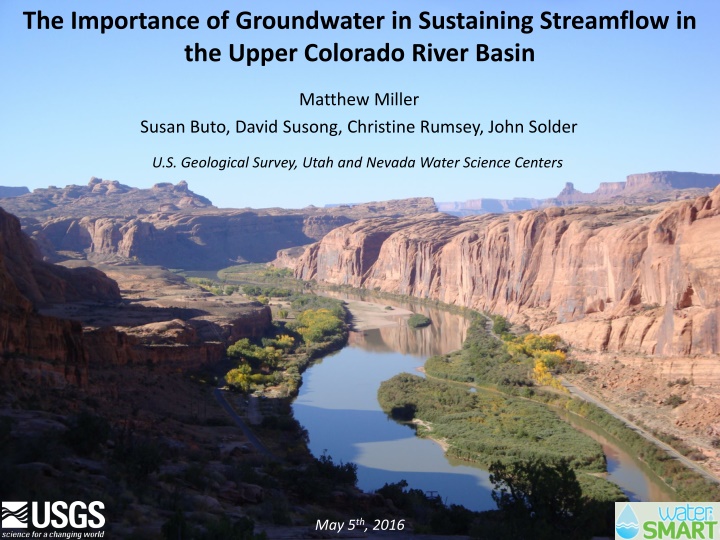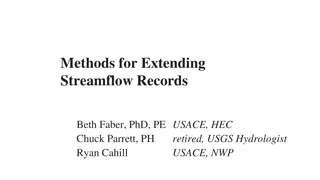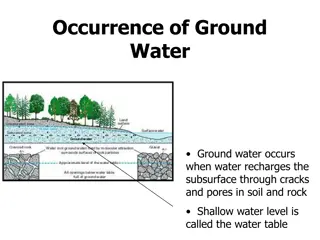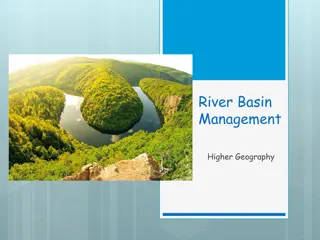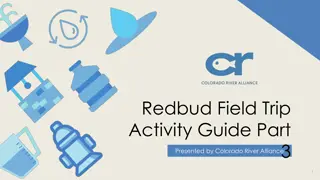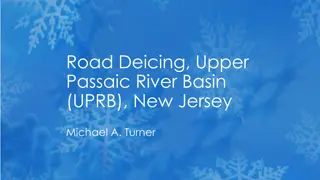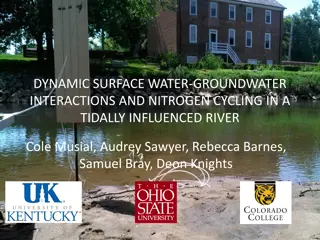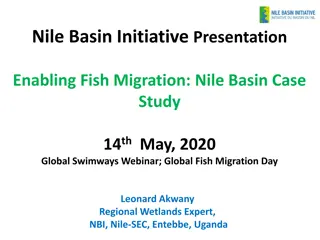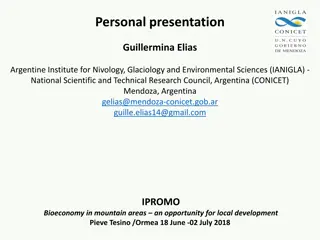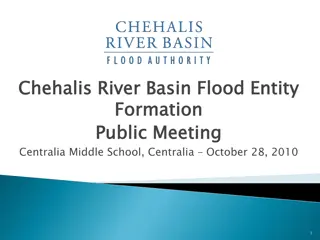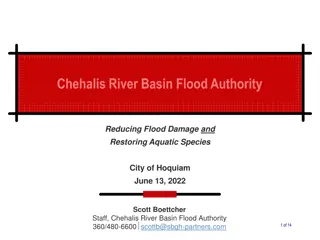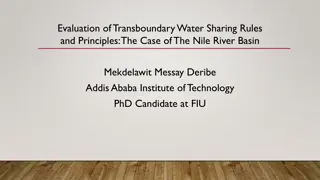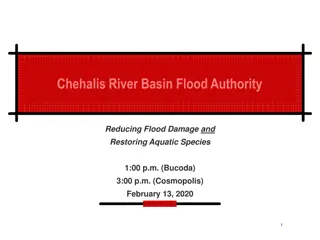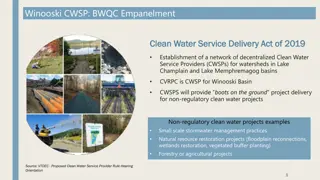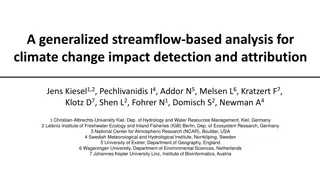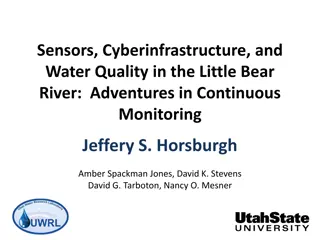Groundwater's Role in Sustaining Streamflow in Upper Colorado River Basin
Groundwater plays a crucial role in maintaining streamflow in the Upper Colorado River Basin. Studies focus on quantifying groundwater discharge, understanding its impact on streamflow, and assessing groundwater age and vulnerability. Research findings highlight the interconnected nature of groundwater and surface water resources. Lack of groundwater information poses challenges for resource management, with projected demand exceeding supply by 2060. Chemical hydrograph separation techniques and long-term USGS records aid in analyzing groundwater contributions to streamflow.
Download Presentation

Please find below an Image/Link to download the presentation.
The content on the website is provided AS IS for your information and personal use only. It may not be sold, licensed, or shared on other websites without obtaining consent from the author.If you encounter any issues during the download, it is possible that the publisher has removed the file from their server.
You are allowed to download the files provided on this website for personal or commercial use, subject to the condition that they are used lawfully. All files are the property of their respective owners.
The content on the website is provided AS IS for your information and personal use only. It may not be sold, licensed, or shared on other websites without obtaining consent from the author.
E N D
Presentation Transcript
The Importance of Groundwater in Sustaining Streamflow in the Upper Colorado River Basin Matthew Miller Susan Buto, David Susong, Christine Rumsey, John Solder U.S. Geological Survey, Utah and Nevada Water Science Centers May 5th, 2016
USGS National Water Census: Colorado River Basin Focus Area Study 1. Evapotranspiration 2. Snowpack Hydrodynamics 3. Water Use Information 4. Groundwater Discharge to Streams Summarized in Bruce and others (2015) USGS Fact Sheet 2015-3080
Project Development and Coordination Objectives developed from a USGS meeting with selected stakeholders including Reclamation Strategy focused on filling in information gaps Lack of groundwater information in UCRB Groundwater and surface water are an interconnected resource Wealth of historic USGS data
BOR Colorado River Basin Supply and Demand Study Overarching Objective Provide quantitative information that adds new understanding of the joint groundwater- surface water resource in the UCRB US Bureau of Reclamation (2012) Projected demand is greater than projected supply Median imbalance of ~ 3.2 million acre-feet by 2060
Study Objectives 1. Determine the spatial distribution of groundwater discharge to streams (where) 2. Quantify the fraction of total streamflow that is supported by groundwater discharge (how much) 3. Quantify the age of groundwater in the UCRB (vulnerability) USGS USGS
Chemical Hydrograph Separation Information from streamflow and chemical composition used to separate streamflow into runoff and groundwater components Miller and others (2014, Water Resources Research)
USGS Long Term Records 1947 Long-term discharge and specific conductance data collected by USGS were used for hydrograph separation. Data from 1984-2012 used for present study 2010
Groundwater Discharge to Streams Summary of 12 Stations in UCRB 1. Pulse of groundwater during snowmelt 2. Percent of total flow that is groundwater a. Annual: 21 58% b. Snowmelt: 13 45% c. Low-flow: 40 86% Hydrograph separation results for Colorado River at Cisco, UT Miller and others (2014, Water Resources Research)
Discrete data Continuous Data Problem: Given a small number of observed SC concentration values, and a continuous record of discharge how can we fill in the gaps in the SC record? Season Discharge + ?2[ln ?2] + ?3? + ?4?2+ ?5[sin(2??)] + ?6[cos(2??)] ln(??) = ?0+ ?1ln ? Time
Groundwater Discharge to Streams Estimation with Discrete Data Excellent fit between groundwater discharge to streams estimated using measured data and a regression approach at sites not directly impacted by anthropogenic activities Miller et al. (2015, J. Hydrol.) Groundwater discharge to streams estimated at 229 sites using regression approach (sites filtered to remove those directly impacted by anthropogenic activities) Rumsey et al. (2015, J. Hydrol. Reg. Stud.)
USGS SPARROW Model Developed to estimate long-term mean steady state water quality conditions
Spatial Distribution of Groundwater Discharge Most groundwater discharge to streams occurs in upper elevation catchments Climate change in high elevation systems will affect the groundwater resource, and therefore the amount of surface water in streams 14.5 maf/yr = Groundwater discharge to streams in Upper Basin 2.7maf/yr = Water delivered to the Lower Basin that originated as groundwater Water lost during in-stream transport due largely to irrigation withdrawals and evapotranspiration Miller and others (in press, Water Resources Research)
Groundwater and Surface Water A Single Resource Yampa River at Steamboat Springs, CO (34% GWD) Colorado River Near Cisco, UT (55% GWD) Mill Creek Near Moab, UT (79% GWD)
Streamflow Sustained by Groundwater On average 56% of streamflow in the UCRB is estimated to be from groundwater discharge Streamflow in lower elevation catchments is more dependent on groundwater discharge than high elevation systems These streams support ecologically sensitive habitats (e.g. riparian zones) Miller and others (in press, Water Resources Research)
Age of Groundwater in UCRB 20% of groundwater < 10 years old 65% < 100 years old Relatively young age of groundwater suggests potential rapid response to changes in environmental conditions Age Tracers 3H, Noble gases, CFCs, SF6, 14C
Summary and Implications 1. Any processes that affect the groundwater resource will also affect the surface water resource Now have quantitative estimates of groundwater discharge to streams 2. Most groundwater discharge to streams occurs in upper elevation watersheds 3. Streamflow in lower elevation systems is dependent on groundwater discharge to streams 4. Most groundwater is young, suggesting the potential for rapid response of groundwater discharge to environmental change 5. Collaborating with Reclamation on study that will use this model as a tool to predict future groundwater discharge to streams under different climate scenarios
Thank you Matt Miller USGS, Utah Water Science Center mamiller@usgs.gov
